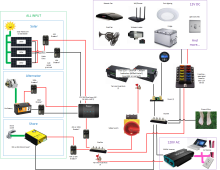clammchops
New Member
- Joined
- Feb 22, 2022
- Messages
- 18

--
A few questions that I have:
- Should this be a 12V system or a 24V system?
- I am not sure on the solar size yet as it depends on the room on the roof. I am thinking somewhere between 500-800W, how will this range change what I need to do in the diagram?
- Is there a more efficient way to wire this?
- I do not know what size breakers/fuses to use, and if I have enough or if I have too many - thoughts?
- Where would grounding wires go in the diagram?
- Any other feedback/comments/concerns with this setup?
UPDATED DIAGRAM, LIST OF KEY ITEMS IN THE SYSTEM, AND QUESTIONS BELOW:

SOLAR:
- 330W Panasonic Solar Panel (x2): Panasonic SC330 330w Mono Solar Panel - Solaris (solaris-shop.com)
- 100/50 MPPT: SmartSolar MPPT 100/30 & 100/50 - Victron Energy
- 30A DC-DC Non-Isolated Charger: Orion-Tr Smart DC-DC Charger Non-Isolated - Victron Energy
- Multiplus - 12V, 2000W, 80A Pure Sine Wave Inverter Charger: Datasheet-Multiplus-inverter-charger_2kVA-and-3kVA-120V-US-EN.pdf (victronenergy.com)
- 300AH Epic Lithium Battery with 150A SmartBMS (x2): Epic LiFePO4 Battery (epicoffgrid.com)
- BMV712 Smart Battery Monitor: BMV-712 Smart - Victron Energy
- Lynx Distributor (DC): Lynx Distributor - Victron Energy
- 400 Amp Mega Fuse: AmazonSmile: Baomain ANL-400A Electrical Protection ANL Fuse 400 Amp with Fuse Holder 1 Pack : Automotive
- Smart Shunt: SmartShunt - Victron Energy
- BMC-712 Smart Battery Monitor: https://www.victronenergy.com/battery-monitors/bmv-712-smart
- Distribution Panel: AmazonSmile: WFCO WF-8930/WF-8950 Ultra Distribution Panel, 30/50 AMP : Electronics
- Solar:
- Do I wire in Series or Parallel?
- Is a 50A breaker sufficient for the solar?
- If I wanted to add a third panel (the same kind), would the system support that?
- Alternator:
- Is the 30A breaker correct, or is there a cheaper/better solution for this? How would you add a 30A fuse on both power wires?
- Shore:
- Is a 30A breaker larger enough?
- All:
- Is the wire gauge correct for all of the connections?
- Is the Lynx Distributor an effective solution, or are there better/cheaper options?
- Is the Battery Monitor needed, or is there a better solution?
- Maybe... Instead of the Smart Shunt/Batter Monitor, how would I incorporate a Cerbo GX and Touch?
Last edited:



